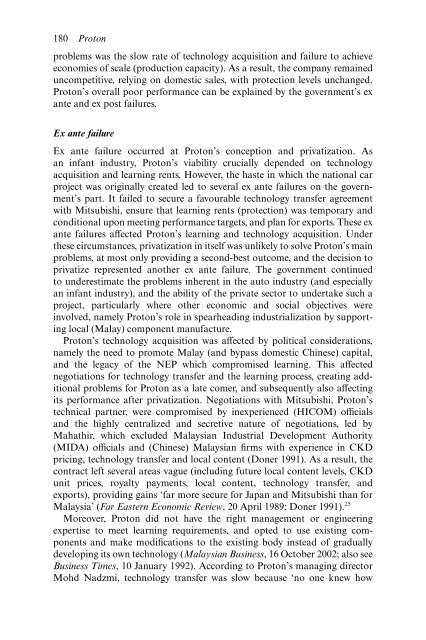PRIVATIZATION Privatization in Malaysia, Regulation, rent-seeking and policy failure
PRIVATIZATION Privatization in Malaysia, Regulation, rent-seeking and policy failure
PRIVATIZATION Privatization in Malaysia, Regulation, rent-seeking and policy failure
Create successful ePaper yourself
Turn your PDF publications into a flip-book with our unique Google optimized e-Paper software.
180 Protonproblems was the slow rate of technology acquisition <strong>and</strong> <strong>failure</strong> to achieveeconomies of scale (production capacity). As a result, the company rema<strong>in</strong>eduncompetitive, rely<strong>in</strong>g on domestic sales, with protection levels unchanged.Proton’s overall poor performance can be expla<strong>in</strong>ed by the government’s exante <strong>and</strong> ex post <strong>failure</strong>s.Ex ante <strong>failure</strong>Ex ante <strong>failure</strong> occurred at Proton’s conception <strong>and</strong> privatization. Asan <strong>in</strong>fant <strong>in</strong>dustry, Proton’s viability crucially depended on technologyacquisition <strong>and</strong> learn<strong>in</strong>g <strong>rent</strong>s. However, the haste <strong>in</strong> which the national carproject was orig<strong>in</strong>ally created led to several ex ante <strong>failure</strong>s on the government’spart. It failed to secure a favourable technology transfer agreementwith Mitsubishi, ensure that learn<strong>in</strong>g <strong>rent</strong>s (protection) was temporary <strong>and</strong>conditional upon meet<strong>in</strong>g performance targets, <strong>and</strong> plan for exports. These exante <strong>failure</strong>s affected Proton’s learn<strong>in</strong>g <strong>and</strong> technology acquisition. Underthese circumstances, privatization <strong>in</strong> itself was unlikely to solve Proton’s ma<strong>in</strong>problems, at most only provid<strong>in</strong>g a second-best outcome, <strong>and</strong> the decision toprivatize represented another ex ante <strong>failure</strong>. The government cont<strong>in</strong>uedto underestimate the problems <strong>in</strong>he<strong>rent</strong> <strong>in</strong> the auto <strong>in</strong>dustry (<strong>and</strong> especiallyan <strong>in</strong>fant <strong>in</strong>dustry), <strong>and</strong> the ability of the private sector to undertake such aproject, particularly where other economic <strong>and</strong> social objectives were<strong>in</strong>volved, namely Proton’s role <strong>in</strong> spearhead<strong>in</strong>g <strong>in</strong>dustrialization by support<strong>in</strong>glocal (Malay) component manufacture.Proton’s technology acquisition was affected by political considerations,namely the need to promote Malay (<strong>and</strong> bypass domestic Ch<strong>in</strong>ese) capital,<strong>and</strong> the legacy of the NEP which compromised learn<strong>in</strong>g. This affectednegotiations for technology transfer <strong>and</strong> the learn<strong>in</strong>g process, creat<strong>in</strong>g additionalproblems for Proton as a late comer, <strong>and</strong> subsequently also affect<strong>in</strong>gits performance after privatization. Negotiations with Mitsubishi, Proton’stechnical partner, were compromised by <strong>in</strong>experienced (HICOM) officials<strong>and</strong> the highly centralized <strong>and</strong> secretive nature of negotiations, led byMahathir, which excluded <strong>Malaysia</strong>n Industrial Development Authority(MIDA) officials <strong>and</strong> (Ch<strong>in</strong>ese) <strong>Malaysia</strong>n firms with experience <strong>in</strong> CKDpric<strong>in</strong>g, technology transfer <strong>and</strong> local content (Doner 1991). As a result, thecontract left several areas vague (<strong>in</strong>clud<strong>in</strong>g future local content levels, CKDunit prices, royalty payments, local content, technology transfer, <strong>and</strong>exports), provid<strong>in</strong>g ga<strong>in</strong>s ‘far more secure for Japan <strong>and</strong> Mitsubishi than for<strong>Malaysia</strong>’ (Far Eastern Economic Review, 20 April 1989; Doner 1991). 25Moreover, Proton did not have the right management or eng<strong>in</strong>eer<strong>in</strong>gexpertise to meet learn<strong>in</strong>g requirements, <strong>and</strong> opted to use exist<strong>in</strong>g components<strong>and</strong> make modifications to the exist<strong>in</strong>g body <strong>in</strong>stead of graduallydevelop<strong>in</strong>g its own technology (<strong>Malaysia</strong>n Bus<strong>in</strong>ess, 16 October 2002; also seeBus<strong>in</strong>ess Times, 10 January 1992). Accord<strong>in</strong>g to Proton’s manag<strong>in</strong>g directorMohd Nadzmi, technology transfer was slow because ‘no one knew how


